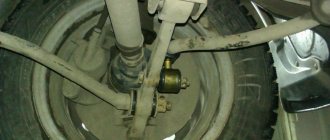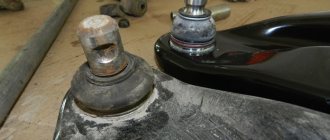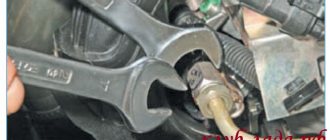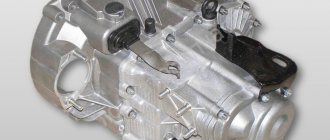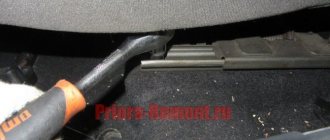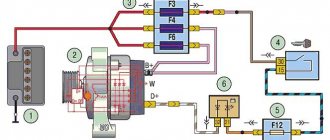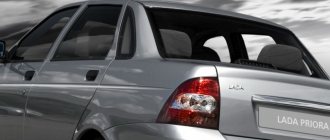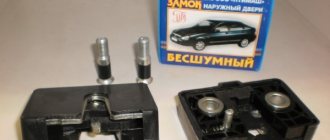Owners of domestic cars, and in particular the VAZ 2170, often resort to suspension tuning, improving the appearance and handling of the car. You can lower the suspension in various ways, which differ both in cost and in the complexity of the work performed. Therefore, before you begin such modifications, you should understand what you want to achieve and how much money you are willing to invest.
- How to properly lower the Priora
Air suspension - Suspension with adjustable ground clearance
- Lowered suspension
Video: replacing the front struts on a Priora
- Video: budget lowering of the Priora suspension
Choosing racks for Priora: the main differences between modern products
Domestic and foreign manufacturers offer high-quality parts. Standardly installed on the SAAZ oil type product model. Their approximate price is 1800-2000 rubles. They are optimal for driving in urban areas and on minor off-road conditions, and cope well with long journeys along the highway. Travel on uneven surfaces is well tolerated for the first 30-40 thousand km, and then they may require replacement.
The Japanese Kayaba racks have also proven themselves positively. The company has recently appeared on the domestic market, but has pleased customers with both a reasonable price and good quality: the elements cope with both off-road driving and highway racing. They have good stability and are able to absorb strong shocks.
When purchasing products, it is important to study the certificate, since there are also low-quality fakes on the market. A novice motorist who is determining which struts are best for a Priora will definitely like the Japanese elements: they are easy to use and install
Domestic Demfi racks are highly durable and reliable. The service life with careful and careful driving can be more than 70 thousand km. The cost of the products is low and every Priora owner can afford to purchase the parts.
It is important to focus on modern motorists who are accustomed to using personal transport for both work and leisure.
Therefore, when choosing which racks to install on a Priora for long-term use, you should pay attention to Demfi products
You can roughly determine which racks on the Priora are better, and which of them will last longer, based on the degree of rigidity of the products.
For example, SS 20 products differ in the degree of shock and vibration absorption. But the buyer needs to remember that rigid elements, completely eliminating roll in corners, will not provide sufficient comfort when driving on uneven road surfaces. Soft types, while guaranteeing ease of control, will not hold the road so well when passing sharp turns and spiral roads.
When studying suitable racks, you should not be guided by price. Cost will not indicate high or low quality. It is set according to the market segment, company rating, and delivery price. Therefore, custom-made products are usually more expensive than domestic analogues.
How much are they asking for Granta and Priora now?
Jokes aside, when you operate with a budget of 300-700 thousand (Granta) or 240-470 thousand (Priora), it’s no laughing matter. Here you need to solve a complex equation with a bunch of variables - the condition of the car, and whether it drives at all, what will be included for that kind of money, how to service it all, and so that there is still change left for buckwheat.
And from this point of view, Priora is better than Granta, because the price range according to the advertisements is higher, and you can save quite a bit on purchasing a LADA Priora. But are the savings worth it?
Also read: Review of used Lada Priora: is it worth buying
Lada Priora front suspension diagram
1 — steering knuckle; 2 - eccentric bolt; 3 — shock absorber strut; 4 — lever; 5 — stabilizer bar; 6 — mounting bracket for the stabilizer bar cushion; 7 — stabilizer bar strut; 8 — cross member of the front suspension; 9 — ball joint; 10 — stretch 1 — telescopic stand; 2 - spring; 3 — rod nut; 4 — rebound limiter of the upper support; 5 — upper support; 6 — bearing; 7 — upper spring cup; 8 — spring gasket; 9 — compression stroke limiter of the upper support; 10 — compression progress buffer; 11 - protective cover
1 — ball joint; 2 - hub; 3 — hub bearing nut; 4 — protective cap; 5 — hub bearing; 6 — steering knuckle; 7 - nut; 8 — front wheel brake disc; 9 — brake mechanism shield; 10 — eccentric (adjusting) bolt; 11 — rotary lever; 12 — front suspension spring;
13 — shock absorber rod; 14 — upper spring cup; 15 — upper support of the shock absorber strut; 16 — shock absorber rod nut; 17 — bearing of the upper support of the shock absorber strut; 18 — spring gasket; 19 — front suspension compression buffer; 20 — protective casing; 21 — rack body; 22 — bracket for mounting the anti-roll bar cushion;
Description of design
Rear suspension elements: 1 — beam; 2 — anti-roll bar; 3 — silent block; 4 — bracket for attaching the lever to the body; 5 - trailing arm of the beam; 6 — brake drum; 7 — shock absorber; 8 — bracket for attaching the shock absorber to the lever; 9 - spring; 10 — shock absorber cover; 11 — spring gasket; 12 — compression stroke buffer; 13 — rear wheel hub; 14 - rear wheel brake mechanism Rear suspension - semi-independent, with an elastic beam, with helical coil springs and double-acting hydraulic telescopic shock absorbers. The longitudinal arms are welded to the beam through reinforcements. To increase lateral stability and reduce vehicle roll, a stabilizer bar made of 14 mm steel rod runs inside the beam. The ends of the rod are welded to the levers.
Rear suspension: 1 — rear suspension beam; 2 — shock absorber; 3 - spring; 4 — bracket for fastening the beam arm to the body
A rubber cushion is installed in the middle part of the stabilizer bar. Bushings are welded to the arms in front, into which silent blocks are pressed. At the rear, brackets with eyes for attaching shock absorbers and flanges for attaching the axles (axles) of the rear wheels and brake shields are welded to the suspension arms. The elastic elements of the suspension are coil springs. The lower coil of the spring rests on a cup welded to the shock absorber reservoir, and the upper coil, through a rubber gasket, rests on a support welded from the inside to the wheel arch. Bolt 1 passes through the inner race of the silent block, connecting the lever to the body bracket. The bracket is attached to the welded studs of the body with three nuts. 2In the lower eye of the shock absorber, a rubber-metal hinge (silent block) is pressed into place, through the central bushing of which a bolt passes, securing the shock absorber to the suspension arm bracket. The shock absorber rod is attached to the body through two rubber pads (one at the bottom of the support, the other at the top) and a support washer (under the nut). The chrome-plated surface of the rod is protected from dirt by a rubber corrugated cover, inside of which a compression stroke buffer is installed. A cylindrical collar made on the axle is designed to center it in the hole of the lever flange and center the brake shield on the axle. An unregulated double-row tapered roller bearing is installed in the hub. During operation, the bearing does not require replenishment of lubricant. The outer bearing ring is pressed into the hub and secured with a retaining ring. The fit of the inner rings of the bearing on the journal is transitional (with a slight interference fit or a small gap). The inner rings of the bearing are tightened in the axial direction with a nut, tightened with a large torque and secured by indenting the nut flange into the groove of the journal.
Shock absorber parts and spring: 1 - shock absorber; 2 - spring; 3 — compression stroke buffer; 4 — rod cushions; 5 — spacer sleeve; 6 — support washer; 7 - spring washer; 8 - nut; 9 — cover; 10 - cover cup; 11 — spring gasket
Rear wheel bearing assembly: 1 - axle; 2 - hub; 3 - bearing; 4 - retaining ring; 5 — washer; 6 — bearing nut; 7 — sealing ring of the hub cap; 8 — hub cap The angles of the rear wheels are set structurally by the geometry of the beam and are not subject to adjustment in operation. The angles can only be checked on a special stand and compared with control values (camber angle - 0°30'±30', wheel toe - 0°10'±5'). If the rear wheel alignment angles do not correspond to the control values, it is necessary to check the condition of the rear suspension elements.
Why is timely replacement of struts on a Priora so important?
Reliable products can ensure good stability of vehicles on the road. It is impossible to determine exactly which racks are best to install on the Priora. When purchasing, you need to focus on the type of product, their hardness and recommendations or reviews of other motorists. But if problems arise with control and driving, replacement of elements is mandatory.
Only new spare parts can guarantee driving safety. Worn struts can lead to roadside accidents and more expensive vehicle repairs.
A sudden breakdown on the highway will require evacuation and cause unnecessary costs. Therefore, Priora drivers must be attentive to restoring the performance and reliability of the vehicle in the event of any malfunction of the racks or auxiliary parts.
How to benefit from increased ground clearance?
Of course, neither the doubled nor tripled ground clearance of the Priora can be compared with the ground clearance of any SUV. However, we should not forget that, in tandem with the improvement of some other characteristics of the car, the Priora’s ground clearance can give good results. Now let's clarify.
The distance from the ground to the lower center point of the Priora is 165 mm. However, knowledge of this fact alone is not enough to draw any conclusions. The motorist must take into account the following characteristics, such as:
- Full length of the machine.
- Distance from front overhang to rear.
- Wheel base.
- Vehicle track width.
- The presence of any parts protruding from the bottom of the machine.
- The extent to which the ground clearance changes when the vehicle is fully loaded.
Only by working to jointly improve all these characteristics can one benefit from increasing the Priora's ground clearance.
Front suspension instructions for installation and repair of Lada Priora
Do-it-yourself modification of VAZ and Lada
Front suspension. Instructions for repairing and replacing suspension parts of the Lada Priora, stages of removing and installing the shock absorber and spring 2171, eliminating knocks and noises in the chassis of the Lada Priora. Repair of the chassis of a VAZ 2170 Priora, instructions for replacing parts in the front and rear suspension of 2172 and 2171 Priora. Examination. The suspension of the VAZ 2170 is independent, telescopic, with hydraulic shock absorber struts, coiled barrel springs, lower wishbones with braces and a stabilizer bar. Malfunctions in the front suspension |
Replacing the telescopic stand
You will need: keys “13”, “17”, “19”. 1. Brake the car with the parking brake and install wheel chocks (“shoes”) under the rear wheels of the VAZ 2172. Raise the front part of the Priora fret with a jack and install it on supports. Remove
Ties for Lada Priora suspension springs, wrench “14”, hex wrench “6”, socket wrench “22”. 1. Remove the telescopic strut from the Priora (see “Removing and installing the telescopic strut”). 2. Clamp the telescopic stand in a vice, squeeze
Spanners, ball joint remover. 1. Lift and place the front part of the VAZ 2170 on supports. Remove the wheel from . Brake the car with the Lada Priora parking brake and install wheel chocks under the rear wheels
Removing and installing the extension
Wrenches “19” (two), “24” (two), spanner “17” (two), wrench for wheel bolts.
- 1. Loosen the front wheel bolts on the corresponding side.
- 2. Lift and place the front part of the VAZ 2170 on supports. Remove the bolts
You should stock up on: keys “13”, “17” (two), a hammer (wooden or polymer). 1. Place the Lada Priora car on an inspection ditch or lift and place the front part on supports. Brake the car with the parking brake of the VAZ 2170
Replacing the hub bearing
The hub is equipped with a double-row ball bearing, which does not require adjustment or lubrication during operation. When pressing out the hub, the bearing is destroyed, so press the hub out of the steering knuckle only for replacement.
- Front suspension
- Rear suspension
Understatement methods that should never be used
Let's look at how the cheapest methods can become the most dangerous. They do not require much time, but the consequences will bring not only disappointment, but also additional difficulties:
- hand cut springs. All you need is a grinder or a metal saw, which cuts off 1.5-3 turns of the spring. The bumpers are also trimmed, and the springs are fixed with a clamp.
- The springs are lowered, and the struts remain old. After such tuning, the chassis quickly breaks down, and the car itself becomes very difficult to drive.
Replacing the front struts on a Priora car will be carried out in the following order:
Lock the car with the handbrake; Jack up the front end and place supports; Using a wheel wrench, moving clockwise, gradually loosen the wheel bolts, and then pull it towards you; Disconnect the brake hoses from the device; Remove the steering tip with a puller; Apply lubricant to the bottom of the device being removed.
Attention! After this step, it is advisable to wait about 10-15 minutes for the lubricant to work well; Unscrew the bolts (you may have to remove the threads); Remove the bottom part of the device from the mount; Unscrew the nuts securing it to the body, remove the shock absorber; Secure the spring with plastic ties (this makes them easier to store); Place the hexagon at the top of the rod (there is a seat). This will keep it from spinning during the next step; The rod nut must be unscrewed, after which you can completely remove the shock absorber; Take out the compression limiter and then the bump stop; Finally, remove the spring, cup, damper, boot.
Installation is carried out in reverse order. Don't forget to check the front strut support bearing - it will most likely need to be replaced.
Flaws
• The white Priora hatchback (photo below) is difficult to see in heavy snow and fog, as it blends in with the environment. In this case, good side lights and driving in compliance with all traffic rules can help.
• In wet and dirty weather it gets dirty quickly, just like cars of any other color. However, on a white car, dirt is clearly visible and striking. Therefore, in the autumn-spring slushy season you will have to wash it more often.
• Drops of bitumen that will inevitably fall on the lower part of the body if you drive along a newly repaired road are best wiped off as quickly as possible. A slight delay and the rye-colored spots will remain on the surface of the Priora hatchback white car forever.
Checking the condition of the chassis and transmission
We check the condition of the chassis and transmission every 15 thousand kilometers. The parts of the chassis (wheels, suspension arms, anti-roll bar, rear suspension beam, shock absorbers and suspension springs) and transmission (front wheel drive shafts) must be free of deformations, cracks and other mechanical damage that affect the shape and strength of the parts. Hanging the front wheels one by one (while the car must be securely fixed on the support stand), we check the condition of the wheel hub bearings.
Use only factory-made support stands. The wheel should rotate evenly by hand, without jamming or knocking.
Holding the wheel in a vertical plane, we alternately sharply pull the upper part of the wheel toward ourselves, and the lower part away from us, and vice versa. We make sure there is no play (knock). If there is a knock on the front wheel, ask an assistant to press the brake pedal. If the knocking noise disappears, then the wheel bearing is faulty, and if the knocking noise remains, then the ball joint is most likely worn out. The hub bearings of the front and rear wheels are not adjustable and must be replaced if there is play. To check the serviceability of the ball joint, insert a mounting blade between the suspension arm and the ball joint housing. Be careful not to damage the ball joint boot.
While pressing the lever with a mounting blade, we monitor the movement of the lever head relative to the ball joint housing. If there is play in the connection, replace the ball joint.
We check the condition of the protective covers of the ball joints. We replace ball joints with torn or cracked covers. To check the silent block of the front suspension arm...
...insert a mounting blade between the body bracket and the lever head... ...and try to move the lever along its axis and along the axis of the bolt. If the lever moves freely, without effort, it means that the silent block of the lever is badly worn or damaged and needs to be replaced. Ruptures, cracking and swelling of the rubber bushing of the silent block are unacceptable. Checking the condition of the silent blocks...
... and the back ends of stretch marks. Tearing, cracking and swelling of rubber silent blocks are unacceptable.
Inspecting the anti-roll bar cushions...
...and rubber bushings for stabilizer struts. If ruptures, cracks or severe deformation are detected on the rubber pads and bushings, they must be replaced. Lifting the rear wheels one by one, we check the condition of the rear wheel hub bearings. The wheel should rotate evenly by hand, without jamming or knocking. To check the condition of the silent block of the rear suspension beam arm...
...we insert the mounting blade between the body bracket and the lever head and try to move the lever in different directions. If the lever moves freely, without effort, it means that the silent block of the lever is badly worn or damaged and needs to be replaced.
We check the condition of the springs, telescopic struts and shock absorbers of the front and rear suspensions. The suspension springs must not be damaged. Tearing, cracking and severe deformation of rubber bushings, cushions and compression buffers of shock absorbers are unacceptable. Liquid leakage from shock absorbers is not allowed. A slight “fogging” of the shock absorber in its upper part, while maintaining the characteristics, is not a malfunction. If the rubber element of the upper support of the front suspension telescopic strut settles or is destroyed, the support must be replaced.
We check the condition of the hinges and the protective cover of the gear shift rod and jet rod. Alternately rotating and turning the front wheels (with the front of the car hanging out)…
...we inspect the protective covers of the outer...
...and internal hinges of the front wheel drives, check the reliability of their fastening with clamps. Covers that are cracked, torn or have lost elasticity must be replaced. We check that there is no oil leakage from the gearbox through the seals of the internal drive joints. If there is a leak, replace the seals.
The VAZ-2110 is considered the predecessor of the Lada Priora; their front suspensions are almost identical, the only differences are in the spring parts and shock-absorbing components. The problems that drivers noted with the VAZ-2110 with front suspension migrated to the Priora - the wheel bearings leave much to be desired, the ball joints wear out quickly and must be regularly replaced.
Color change
“First impressions: the car needs to be rolled out, it doesn’t drive. There is no sound insulation, locks and door handles require improvement. The standard tires are noisy and dull. You’re riding like you’re on stumps.”
“In two difficult months, the car covered 18,000 km, but did not cause any problems. The chassis, in my opinion, is quite tolerable, the only thing is that a knock is heard in the right pillar when passing speed bumps. I came to the service, looked at it - everything is fine, they say it’s their illness. The brakes are not bad, 4"...
I compare the impressions of Moscow Prior owners with my own. The cars have the same 98-horsepower engines, so there are no fundamental differences in movement. The suspensions regularly absorb large bumps, but shake on small bumps. However, the gray car is more interesting at the level of nuances: it is more composed in corners, a little more stable on the way out, and absorbs road bumps more smoothly.
In terms of acceleration dynamics, the new and old “Priors” are practically no different from each other, while a noticeable monotonous rumble fills the interior. I remember that during our first meeting with the car they told us about improving the sound insulation. We measured the noise level in the cabin (both Prioras were shod with the standard Kama-Euro) and were surprised: the new car turned out to be not as quiet as the previous version! The reason was found in the trunk: it turned out that the carpet in the pre-restyling car was thicker.
The steering is equally uninformative, and the updated car has a sharper steering wheel only in the Lux. We are waiting for him in other modifications.
“The transmission works fine, except for first gear. I switch to lower with effort. This happened to me on all Zhiguli cars, from the “six” to the “ten,” - I continue to study the forum of Prior owners.
The white Priora has a similar behavior, but here the fifth gear is difficult to engage. I push the lever by force, and it doesn’t work the first time. In a restyled car, it is more convenient to operate the lever. New cable driven unit? Unfortunately, no: both have well-known boxes with the VAZ-2112 index, which my colleague was not enthusiastic about when he tried out the new Priora in Tolyatti. Therefore, they decided: these are the features of specific machines. I would like to believe that the better performance of the transmission is evidence of improved build quality. By the way, when the engines are idling, the gearbox levers of our pair vibrate equally strongly.
Engines and transmissions
In 2001, a new facelift model of the VAZ 2110 was introduced. The car had slightly more rounded edges and a modernized front bumper. Until 2004, the offer included 1.5-liter gasoline engines with a power of 77 or 92 hp. With. Since 2004, larger 1.6-liter 80- and 89-horsepower engines have been installed under the hood. Power was transmitted to the front wheels through a 5-speed manual transmission 2110.
A year after its debut, the sports version 21106 GTI appeared. The transmission here is based on a 2-liter 150-horsepower engine from Opel, which allowed acceleration to just over 200 km/h. Car enthusiasts are also familiar with the Lada 110 Premier, the difference of which was that the body was increased by 19 cm. It can often be found in the form of a taxi. Under the hood is a 1.8-liter gasoline engine producing 98 hp. With. In 2009, production of the Lada 110 was completed, and the Priora became the model's successor. The VAZ 2110 was offered in sedan (2110), station wagon (2111), five-door hatchback (2112) and coupe (21123) body styles.
The main “disease” of all VAZ 2110 engines is the cooling system. Oxides and deposits often collect here and become clogged in the engine casing and radiator. Due to a malfunction of the sensor, the electric fan periodically fails. The tens clutch also usually fails quickly during aggressive driving.
Every owner of a Ten is faced with the need to replace a piston - the one on the Priora is perfect here. It will significantly improve the technical characteristics, but such an exchange is best carried out after 120,000 km.
Salon VAZ-2110
If we compare the VAZ 2110 and Priora, Russian manufacturers have been upgrading the latter’s 1596 cc engine for many years. The four-cylinder sixteen-valve engine produces 72 kW/98 hp. With. at 5600 rpm and a maximum torque of 145 Nm at 4000 rpm, which, according to available data, allows the Priora to reach a top speed of 183 km/h, and provides acceleration to 100 km/h in 11.5 s.
Content
- How much are they asking for Granta and Priora now?
- Where there is more space: comparison of “Grants” and “Prioras” in size
- Which is better in terms of equipment - Priora or Granta?
- Which is better on the go - Lada Granta or Priora?
- What is better to look at second hand - Lada Granta or Priora?
The population of Russia is not getting richer for the eighth year in a row, so questions about whether to take a Grant or a Priora will arise more and more often. Along with other important questions like, what is the “doshika” course these days and “can I wear these pants for the ninth year in a row”?
Suspension arms or beam - check fastenings and silent blocks
One of the common causes of knocking in the rear suspension is the beam. If your car has such a suspension design, it is worth determining the exact location of the knock. To do this, you need to put the car in a pit, ask someone to rock the car, and in the pit, grab hold of various places on the beam with your hand. Most often we are talking about the knocking of the silent blocks of the rear beam. The suspension arms may also knock, and here the diagnosis will be somewhat more complicated:
- you need to install the car in the pit, putting it on speed, and not on the handbrake, then climb into the pit, taking with you a pry bar, a large screwdriver, and a set of keys;
- using a mount, check the functionality of the bushings and silent blocks; if they move easily in their seats and noticeably play, they need to be replaced;
- check the integrity of the suspension arms, their bending can lead to knocking and uneven running of the car, and cracks indicate the need for quick replacement;
- the fastenings of the levers can be loose, for this you need to use keys and tighten all visible connections, this will help eliminate this item from the causes;
- When the suspension elements are deformed, the levers themselves can knock on body parts and other elements of the rear suspension space while driving, so you can rock the car and find out.
Anti-aging treatments
As soon as you start the engine, the new car’s low beam headlights flash, even if the switch is in the “0” position - convenient. The indicator squeaks to warn you that your seat belt is not fastened, and when you lightly touch the steering column, the turn signal flashes three times.
I turn on the side lights sequentially, then the headlights... Not one icon appears on the instrument panel, like in an old car, but two. It’s a small thing, but now you don’t have to guess what lighting equipment works.
The new instrument panel is more interesting in terms of design. In general, there were no special complaints about the previous one, but it was too simple and had already become familiar. And then there were the wide white arrows and well-arranged pictograms, and I immediately fell in love with the new product.
The updated dashboard not only refreshed the interior, but also added convenience. The on-board computer screen was placed in the center. There is no unnecessary beauty on the monitor, everything is simple, but large numbers are clearly visible in motion.
The driver's position is praised by many owners, but being 190 cm tall, I feel uncomfortable in the seat: there is very little space in the area of the pedal assembly of the old car, and there is not enough longitudinal adjustment of the seat. The updates have corrected the situation a little: the seat slides in the new car have been lengthened, so you don’t have to lean the back too much back.
The chair is denser, it better fixes the body in turns. The distance between the gas and brake pedals is noticeably greater. Having adjusted the driver's seats in both cars, I tried to sit back and couldn't. The backs were too close to the rear sofas. And if four people get into the car, I, the driver, will have to press my knees to my ears.
Engine and gearbox problems
If we talk about power plants, in general they are quite reliable (at least when compared with the “decimal” ones). The timing system is belt driven. The belt runs for quite a long time - up to 120 thousand kilometers. However, the roller and pump may fail earlier, which leads to a break in the timing drive or overheating of the motor in the first and second cases, respectively.
By the way, the “Prior” engine has different pistons, crankshaft and lightweight connecting rods. The resource of the internal combustion engine is about 300-350 thousand kilometers.
Among the common problems on Priora is difficult starting. The reason for this is a low-quality standard battery. Its service life is no more than one year. The owners strongly recommend replacing it with a better one so as not to experience problems with starting, especially in winter.
Now about the transmission. All power units are paired with a five-speed manual transmission. It has been significantly improved and is now equipped with a cable drive. Shifting gears is clear, without hesitation. The clutch lasts up to 100 thousand, depending on driving style. The box itself has no major flaws. The recommended transmission oil change interval is 60 thousand kilometers.
Chassis SS20
These spare parts for domestic and foreign cars are produced under the “System Technologies” brand. These racks have become so popular due to their high quality. For Priora, the manufacturer offers 4 product options that differ in hardness. Which stands are better? They need to be selected according to your driving style. The softest ones are the “Standard” series racks. Rear shock absorbers from the same series are also offered.
A reinforced version is offered to increase the load capacity. Next are the “Comfort” racks. According to reviews from many car owners, this is the best option. They are stiffer than the Standard, but the suspension works equally well on bad and good roads.
The “Highway” kit is suitable for those who like stiff suspension and high speed. With these racks you can drive on bad roads, but it will be uncomfortable. “Sport” is the toughest option from this manufacturer for Priora cars. A front suspension of this type is not very suitable for the city, but for sports competitions it is just right.
Pros and cons of a white car
Advantages of painting a Priora white hatchback car:
• Of course, a chic appearance! White color can visually increase volume. Therefore, clean and sparkling in the sun, as if from a picture, the white Priora hatchback always has an impressive and at the same time elegant appearance.
• In dry weather, dust and dirt are much less visible on it than on cars with a dark color. Pollution becomes noticeable only from a close distance, but from a distance the car appears clean. Accordingly, cleaning costs are reduced.
• White color tends to reflect sunlight. This is especially felt in the summer heat. The white Priora hatchback (photo below) heats up much less.
• It is clearly visible on the road, including at night. This most likely determines the statistics of accidents - white cars get into them much less often.
• The purer the white color of your Lada, the less susceptible it will be to fading. In case of repairs and the need for touch-up, it will be much easier to choose a shade that best matches the original one.
• Small scratches and chips are much less noticeable. This is because paint primer is usually white. Therefore, if the scratch is shallow, then it is not visible.
• White Priora hatchback lends itself very well to modernization. Tuning (pictured), which will make your car original, can be done with your own hands.
How to disassemble the front and rear suspension
The chassis consists of 41 parts, so disassembly takes longer and assembly may require additional adjustments. The process looks like this:
- Using a wheel wrench, loosen the bolts on the wheel one by one and pull the car onto an inspection hole or overpass. Be sure to tighten the handbrake - this will lock the rear ones, now remove the front ones.
- Unscrew the nuts from the hubs, now you can remove the steel ball joint rod from the damper strut.
- Disconnect the stabilizer from the lever. Unfasten the ball joints from the steering knuckle and remove them.
- Disconnect the bracket from the body, and then remove the extension. At the same time, loosen the pad holders.
- Tie the brake caliper, leaving it attached to the hose. Removing it is not so difficult, but installing it is much more difficult, so it is easier to leave it hanging.
- Unscrew the nuts from the damper, remove it, and then the protective fist.
- Using socket wrenches, remove the fastenings of the ball joint and steering knuckle. Be careful not to damage the protective cover of the hinge.
- Analysis of the rear chassis looks like this:
- Place the car on the pit (it is better, of course, to use a lift);
- Open the trunk, under the trim (which covers the wheel arches) loosen the shock absorber bolts.
- Gradually loosen the wheel bolts and remove them.
- Unscrew the brackets securing the handbrake cables, then remove them - otherwise they will get in the way. Unscrew the drum mechanisms, cable ends, flanges.
- Remove the brake pipes. Unscrew the drive lever washer, then remove the drive itself.
- Remove the damper supports.
- remove the stand.
- Unscrew the fasteners of the beam (from below), and smoothly lower it to the ground.
Problems when paying with bank cards
Sometimes difficulties may arise when paying with Visa/MasterCard bank cards. The most common of them:
- There is a restriction on the card for paying for online purchases
- A plastic card is not intended for making payments online.
- The plastic card is not activated for making payments online.
- There are not enough funds on the plastic card.
In order to solve these problems, you need to call or write to the technical support of the bank where you are served. Bank specialists will help you resolve them and make payments.
That's basically it. The entire process of paying for a book in PDF format on car repair on our website takes 1-2 minutes.
If you still have any questions, you can ask them using the feedback form, or write us an email at
Lada Priora
This car was released relatively recently and has already earned the respect and sympathy of car owners throughout the country.
To get to know Priora better, it’s worth taking a look at its strengths:
Appearance. One of the main strengths that ensured Lada good sales. Judging by the design, we can say that this is a man's car. Features from the Granta are noticeable in the front fenders and hood. Other elements, such as the front bumper, radiator grille and optics, are new.
Thanks to its unique external features, Priora stands out clearly in the city traffic, attracting attention.
Suspension. There are also slight similarities with previous models. This fact gives the buyer absolute confidence in the quality of the suspension, because the products of the VAZ plant have always been distinguished by their indestructibility and ability to overcome even the most difficult obstacles
Based on this, we can say with confidence that Priora will feel great on our roads.
New control panel. The new panel cannot be called domestic in any way. The standard European design is clearly visible here. The panel has become more attractive and has acquired new functions.
Sport car
Very often, cars of the VAZ family are chosen as racing cars, especially for amateur competitions. One of the most suitable for these purposes is the white Priora hatchback. Pictures of sponsors advertising, riders' names and serial numbers are visible from afar on a white background.
Even the basic version of the car, the white Priora hatchback, features a sporty look. Tuning (photo below) will give it an aggressive and brutal look. Of course, a lot of work is required to upgrade the standard equipment to the racing version. But, as shown in the photo, the white Priora hatchback allows you to do it even in a garage, especially since there are no problems with purchasing components and spare parts for the Lada.
LADA Priora is one of the most expensive and at the same time best-selling domestic cars. Local car enthusiasts prefer the Priora because it is considered a car that has stood the test of time. But deciding on a car brand is only half the battle. It is clear that we are taking Priora. But here an “internal” dilemma arises: which Prior should we take? And if your wallet will quickly help you decide on the configuration, then choosing the body type is not so simple. Priora sedan or hatchback - which car is worthy of being in your garage?
"Bogdan"
The coexistence of the previous model and the new one in the same market is a worldwide practice. As soon as the new version finally puts the previous one to shame, production of the old model is stopped or transferred to other countries. So the painfully dear sedans and station wagons of the tenth family, having left the assembly line in Togliatti, appeared in the model range of the Ukrainian corporation Bogdan.
The new VIN code did not scare off fans: in Russia alone in 2010, more than 5 thousand Extogliatti small cars were sold, and in the first half of 2011 - more than 3 thousand. Since we have a dime a dozen sedans in this class, we decided to understand why aliens from the past captivate buyers using the example of the Bogdan-2111 station wagon and its direct relative, the Lada-Priora.
In Russia, the tenth family left the main conveyor in stages. In 2007, the sedan left the scene. The hatchback and station wagon lasted two years longer, then the family finally gave way to the Priora. Although the factory stubbornly insists that this is not a restyling, but a radically redesigned car, the buyer is skeptical about such statements.
Tuning
As shown in the photo, the white Lada Priora hatchback is one of the cars that most successfully accepts the modernization of its appearance. Even a simple replacement of standard bumpers with restyled ones and tinting the windows gives the car individuality. However, the fantasies of car owners do not end there.
• Various types of body kits are used in the color of the Priora (pictured) hatchback white. Tuning bumpers and radiator grilles, installing a spoiler sometimes make a car completely unrecognizable, aggressive and impressive.
• Photo of a white Priora hatchback, tuning it in a retro style, can often be seen on the streets. Chrome-plated hubcaps in the style of the 50s of the last century and white rims on the wheels leave no one indifferent.
• The Lada Priora hatchback (pictured) is white, with red lighting at the bottom and looks very original.
• High-quality LEDs and eyelashes installed on a white Priora hatchback (photo below) will make the headlight tuning complete and the appearance seamless.
Basic faults
A beam can fail for two reasons:
- displacement from place;
- mechanical damage (most often a crack).
When a crack occurs in the lever, the torsional rigidity of the body decreases. This parameter determines the degree of safety, as well as the position of the parts. The fact is that with normal body rigidity, which is laid down during design and obtained after the final stage of car assembly, absolutely all components and assemblies (down to the bolts) are in place, they have a maximum permissible vibration amplitude. For example, the suspension “swallows” potholes - the parts actively move, and people in the cabin may not even notice the rolling.
In addition to the fact that you will most likely have to get used to unpleasant sounds, there will be increased wear and tear on small parts. When a lever cracks, everything that is attached to it begins to move with greater amplitude. The problem is temporarily solved by welding, but this only postpones the solution to the problem for some time. Craftsmen recommend changing the beam.
Where there is more space: comparison of “Grants” and “Prioras” in size
Both cars fit into the classic B-class format with a length of just over four meters. In this sense, “Priora” seems to be more advantageous - there are as many as 4.3 m from nose to tail, while “Granta” is 4.2 with a tail. But, as often happens, it is not the sheer size that is important, but the ability to use it.
Mainly in the interior layout.
And the Granta developers did a better job with this task: the seating position in both rows is not striking, but better than the “Prior” one. The knees, of course, rest against the back, and the top of the head rests against the ceiling, but the Priora is ruined by the frankly low seating position on the rear sofa, for example, because of which the legs, which have nowhere to put anyway, also have to be bent.
The Priora engineers did not squeeze anything out of the size in terms of the trunk: the sedan has a modest 430 liters even by B-class standards, while the plump rear of the Granta holds 520 liters.
For station wagons, the situation is slightly different: 444 liters for the Priora VS 360 liters for the Granta. But sitting in the Priora “car” does not become more spacious, so in this respect the “Grant” is better than the “Priora”.
Also read: Used LADA Granta: execution cannot be pardoned
